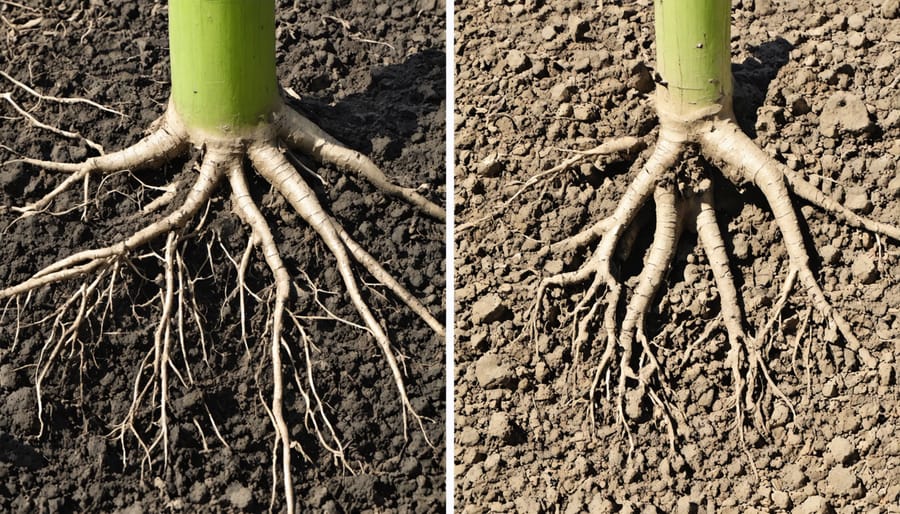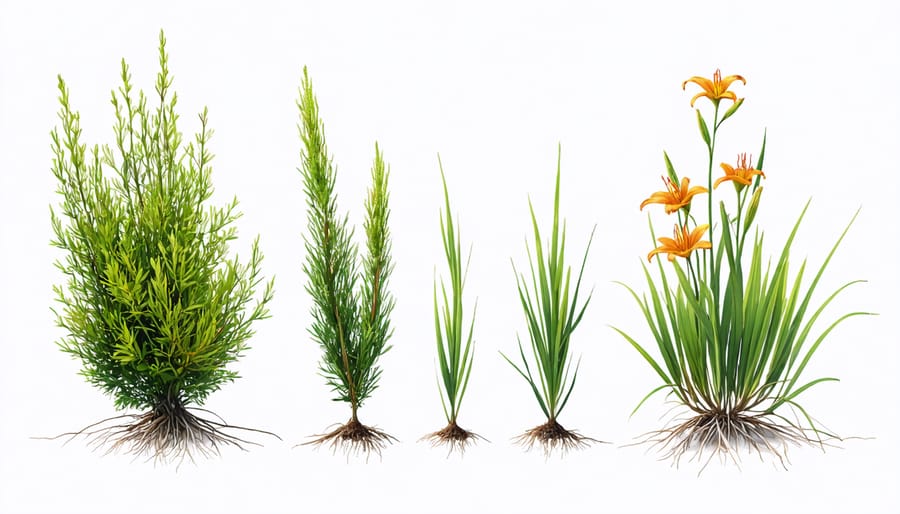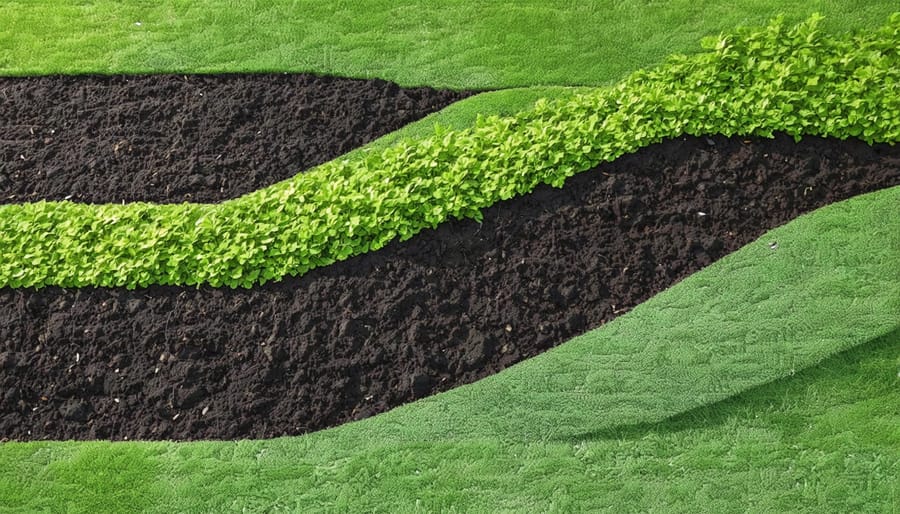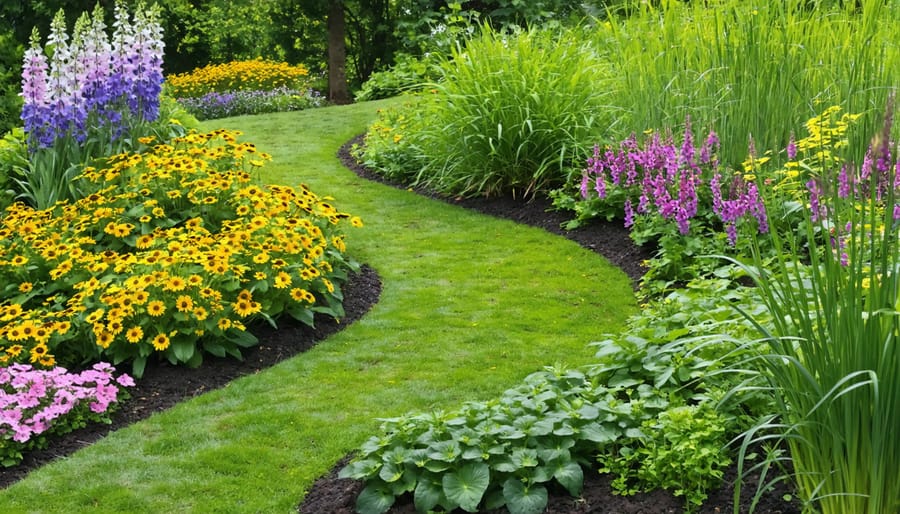Plant deep-rooted perennials like Black-Eyed Susans and Switchgrass strategically along slopes to create natural erosion barriers that grip soil with extensive root systems while adding year-round visual interest to your garden. These resilient plants work tirelessly beneath the surface, developing networks of roots that can extend several feet deep, anchoring soil particles and preventing washout during heavy rains.
Nature has perfected the art of erosion control over millions of years, and our gardens can harness this same protective power. When we combine layers of ground covers, mid-height perennials, and taller plants, we create a living shield that breaks the impact of raindrops, slows water flow, and holds soil in place through every season. This natural approach not only prevents soil loss but also builds healthier garden ecosystems that thrive with minimal intervention.
Understanding the relationship between plants and erosion isn’t just about protecting soil – it’s about creating resilient landscapes that work with nature rather than against it. By selecting the right plants and positioning them thoughtfully, gardeners can transform problematic slopes into stable, beautiful spaces that grow stronger with each passing year.
Understanding Soil Erosion in Perennial Gardens
Common Signs of Erosion Problems
Being able to spot erosion early can save your garden from serious damage. Watch for exposed plant roots, which occur when soil washes away from the base of your plants. You might also notice small channels or gullies forming in your garden beds, especially after heavy rain.
Soil collecting at the bottom of slopes or against walls is another telltale sign. If you find sediment in your garden pathways or notice that mulch keeps washing away from certain areas, these are clear indicators of erosion at work.
Keep an eye out for changes in soil level around permanent structures like fence posts or garden edging. If you can see more of the post than before, soil erosion is likely the culprit. Muddy or cloudy runoff during rainstorms also signals that your soil is being carried away.
In established garden beds, uneven soil surface or bare patches where plants struggle to grow can indicate ongoing erosion issues. Plants that frequently topple over or seem to sit higher on their root balls than when first planted are also warning signs that shouldn’t be ignored.

How Erosion Affects Plant Health
Erosion can significantly impact plant health by destabilizing the foundation that supports their growth. When soil erodes, it directly affects the root systems of plants, making it harder for them to anchor themselves and access vital nutrients. Think of your garden’s soil as a well-stocked pantry – when erosion occurs, it’s like slowly emptying those shelves of essential ingredients your plants need to thrive.
The loss of topsoil through erosion is particularly concerning because this layer contains the highest concentration of organic matter and nutrients. Without proper soil management techniques, plants may develop shallow root systems, making them more vulnerable to drought and strong winds. You might notice your plants looking stressed, with yellowing leaves or stunted growth, as they struggle to find the nutrients they need.
Water retention also becomes a challenge in eroded soil, creating a cycle where plants receive either too much or too little moisture. This stress can weaken your garden’s overall resilience and make plants more susceptible to diseases and pest problems. The good news is that understanding these effects helps us take better care of our gardens and implement effective prevention strategies.
Plant-Based Solutions for Erosion Control
Best Perennials for Erosion Control
When it comes to fighting erosion, certain perennials excel at holding soil in place while adding beauty to your landscape. These hardy plants develop extensive root systems that act like natural anchors, making them perfect for slopes and areas prone to soil loss. As part of your perennial garden maintenance, these reliable options will serve you well year after year.
Creeping Phlox (Phlox subulata) creates a dense carpet of colorful blooms in spring, with roots that spread and grip the soil effectively. Its low-growing nature makes it perfect for steep banks and garden edges.
Day lilies (Hemerocallis) are practically unstoppable once established, featuring deep roots that hold soil firmly in place. These adaptable beauties come in countless colors and bloom throughout summer.
Black-Eyed Susans (Rudbeckia) not only brighten your garden with cheerful yellow flowers but also develop robust root systems that prevent soil erosion. They’re drought-tolerant and spread naturally, filling in bare spots quickly.
For shady areas, try Japanese Forest Grass (Hakonechloa). Its graceful leaves cascade down slopes while its fibrous roots create an effective soil-holding network.
Yarrow (Achillea) thrives in sunny spots and poor soil, making it ideal for challenging areas. Its deep roots and spreading habit help prevent soil loss while providing months of butterfly-attracting blooms.
Remember to combine different types of these erosion-fighting perennials for the best results. Their varying root depths and growth patterns will create a more effective soil-stabilizing network while adding visual interest to your garden.

Strategic Plant Placement
Strategic plant placement is key to maximizing erosion control in your garden. Start by identifying areas most vulnerable to erosion, typically slopes, areas with water runoff, and spots where soil tends to wash away during rain. These areas should be your primary focus for plant positioning.
Create a multi-layered approach by combining different types of plants. Position taller shrubs and deep-rooted plants at the top of slopes, where they can anchor the soil and slow down water flow. Medium-sized perennials work well in the middle sections, while ground covers and spreading plants are perfect for the bottom areas where they can catch soil and slow water movement.
Space your plants closer together in erosion-prone areas than you typically would in regular garden beds. This creates a denser root network that holds soil in place more effectively. A good rule of thumb is to reduce typical spacing by about 25% when planting specifically for erosion control.
Consider creating planting zones that follow the natural contours of your landscape. Plant in staggered rows across slopes rather than up and down them. This pattern helps create natural terraces that slow water flow and prevent soil loss. For steep slopes, consider combining plants with hardscaping elements like rock gardens or terracing to provide additional stability.
Remember to maintain clear pathways between planted areas to allow for maintenance access without compromising the soil-holding properties of your design.
Root System Benefits
Root systems are nature’s incredible engineering solution to soil erosion, working tirelessly beneath the surface to hold our gardens together. Different plants develop varied root structures, each playing a unique role in preventing soil loss and maintaining landscape stability.
Deep-rooted plants, like native prairie species and ornamental grasses, send their roots several feet into the soil, creating natural anchors that stabilize slopes and prevent deep soil movement. These vertical root systems act like living stakes, holding layers of soil together while creating channels for water to penetrate deeper into the ground.
Fibrous root systems, commonly found in many perennials and groundcovers, spread horizontally near the surface, forming dense mats that excel at catching and holding topsoil. Think of them as nature’s safety nets, catching soil particles before they can wash away during heavy rains.
Tap roots, like those found in dandelions and butterfly weed, combine the best of both worlds. Their thick central root provides deep anchoring, while smaller lateral roots spread outward to grip surrounding soil. This combination creates excellent erosion control while also improving soil structure.
Some plants, such as willows and elderberries, develop extensive lateral root networks that can spread well beyond the plant’s canopy, offering erosion protection across larger areas. These root systems are particularly effective along waterways and steep slopes where soil stability is crucial.
Supporting Practices for Erosion Prevention
Mulching Techniques
Mulching is one of the most effective and natural ways to combat soil erosion while improving your garden’s health. Think of mulch as a protective blanket for your soil, shielding it from harsh weather conditions and preventing soil particles from washing away during heavy rains.
Organic mulches, such as straw, wood chips, or shredded leaves, offer excellent erosion control while gradually decomposing to enrich your soil. Apply these materials in a layer 2-3 inches thick, making sure not to pile them against plant stems or tree trunks. This thickness provides optimal protection while allowing water to penetrate and reach plant roots.
For steep slopes, consider using heavier mulch materials like bark chunks or pine needles, which are less likely to wash away. These materials also interlock naturally, creating a more stable surface. Sheet mulching, also known as lasagna gardening, involves laying down cardboard or newspaper first, then adding organic materials in layers. This technique is particularly effective for establishing new garden beds while preventing erosion.
Living mulch, such as low-growing groundcovers, offers a dynamic approach to erosion control. These plants not only protect the soil but also create habitat for beneficial insects and add visual interest to your garden. When using living mulch, space plants closely enough to create a dense mat but far enough apart to allow for healthy growth.
Remember to refresh your mulch annually, or when you notice significant decomposition. In autumn, fallen leaves can be shredded and used as free mulch, making the most of nature’s own erosion control system. Keep mulch at least 6 inches away from building foundations to prevent moisture problems.

Soil Amendment Strategies
Improving your soil’s structure is one of the most effective ways to combat erosion, and it’s easier than you might think! Start by incorporating organic matter like compost, which acts like a sponge to help soil retain moisture while improving its structure. Adding 2-3 inches of well-rotted compost to your garden beds each season will gradually build up soil resilience.
Mulching is another powerful strategy that serves multiple purposes. A 2-3 inch layer of organic mulch – whether wood chips, straw, or leaves – protects soil from rain impact, reduces water runoff, and slowly decomposes to enrich the soil. As experienced gardeners often say, “Feed the soil, and the soil will feed your plants.”
Consider adding cover crops during off-seasons or in areas waiting to be planted. Quick-growing options like annual ryegrass or clover help bind soil particles together with their robust root systems while adding valuable organic matter when turned under. These “green manures” work tirelessly to improve soil structure even when your garden isn’t actively producing.
For steep slopes or areas with severe erosion problems, try incorporating soil amendments like vermiculite or coconut coir. These materials improve drainage while helping soil retain moisture and nutrients. Adding a small amount of clay to sandy soils can also help particles stick together better, reducing erosion risk.
Remember to test your soil pH and adjust it accordingly with lime or sulfur – balanced soil chemistry promotes better root growth and soil structure. Work these amendments in gently, avoiding excessive tilling which can actually increase erosion potential. With consistent attention to soil improvement, you’ll create a garden that’s naturally resistant to erosion while supporting healthy plant growth.
Maintenance Tips for Long-Term Success
Once you’ve established your erosion control measures, maintaining them is crucial for long-term success. Regular monitoring and care will ensure your plants continue to protect your soil effectively while thriving in their environment.
Start by implementing proper watering techniques to prevent soil displacement. Water deeply but gently, using a soaker hose or drip irrigation system rather than overhead sprinklers that can dislodge soil particles.
Check your plantings regularly for signs of stress or damage, especially after heavy rains or storms. Look for exposed roots, soil washing away from plant bases, or areas where mulch has thinned. Address these issues promptly by adding fresh mulch or adjusting plant positioning as needed.
Maintain healthy plant growth by fertilizing appropriately – but don’t overdo it! Too much fertilizer can lead to excessive growth that may not be sustainable. Instead, focus on building healthy soil through regular addition of organic matter and compost.
Prune your erosion-control plants as needed to encourage dense growth and strong root systems. Remove dead or damaged stems promptly, and divide overcrowded perennials every few years to maintain optimal spacing and coverage.
Keep an eye on your mulch layers throughout the seasons. Replenish organic mulch annually, aiming for a depth of 2-3 inches while keeping it away from plant stems to prevent rot. In steeper areas, consider using erosion control blankets until plants establish themselves fully.
During the first two growing seasons, pay extra attention to new plantings. Young plants need consistent moisture and may require temporary erosion control measures until their root systems develop fully. Remember that a well-maintained erosion control garden not only protects your soil but also creates a beautiful, sustainable landscape that improves with age.
As we’ve explored, the relationship between plants and erosion control is vital for maintaining healthy, sustainable gardens. By implementing a combination of strategic plant selection, proper placement, and soil management techniques, you can effectively protect your garden from erosion while creating a beautiful landscape. Remember that even small steps, like adding groundcover plants or installing a simple rain garden, can make a significant difference in preventing soil loss. Take time to assess your garden’s specific needs and gradually incorporate these erosion control strategies. With patience and dedication, you’ll not only preserve your soil but also contribute to a more resilient and environmentally friendly garden space. Start with one area of your garden today, and watch as your erosion control efforts flourish into a thriving, stable ecosystem that will bring joy for years to come.




